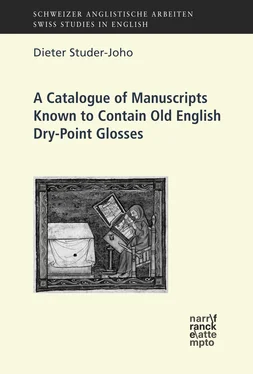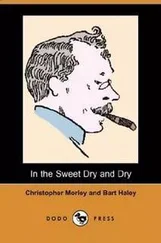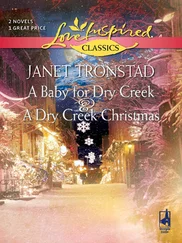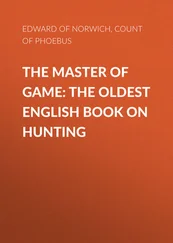Meritt (1945) eventually published the accumulated harvest of his deciphering efforts in his edition of ca. 2300 OE glosses from 42 MSS, of which 9 MSS contain dry-point material, namely [4/K:40] (Meritt 1945: nos. 28 and 31), [5/K:52] (nos. 27 and 66), [7/K:61] (no. 1), [10/K:95] (nos. 13 and 24), [17/K:198] (no. 4), [19/K:252] (no. 2), [21/K:266] (no. 16), [25/K:293] and [26/K:313] (no. 65).
Meritt devotes a short excursus (1945: viii–ix) to dry-point glosses and briefly outlines some issues surrounding them, especially their visual difficulties. He points out that both a training of the eye and conducive lighting are essential and that skimming natural light is often most advantageous. Meritt especially emphasizes the negative effect of electric light, “which throws a sheen on the page” (Meritt 1945: ix) and hence effectually obliterates the faint visual information provided by the dry-point glosses. Comparing Meritt’s (1945) representation of dry-point glosses to more recent dry-point gloss editions like Page (1981), Nievergelt (2007) or Ernst (2007), one cannot help but notice that there are comparatively few doubtful dry-point readings included in Meritt’s account and that he hardly ever expresses uncertainty about any of his readings. In a few places, Meritt insinuates that he did not include all the dry-point material that he encountered in his forays, and hence one may assume that he intentionally skipped doubtful cases.2 Standing in the OE lexicographical tradition, he never edits L. dry-point glosses, either, which he surely must have encountered and identified as such in order to separate them from OE specimens.
Incidentally, if my identification of London, British Library Royal 15 B. xix [22/K:268] as an OE dry-point gloss MS is correct (see below p. 116), this MS may serve as a reminder that the lack of reports of dry-point glosses for a particular MS must not automatically be taken as evidence that the MS may not yield previously unnoticed material upon further scrutiny on a different day. Meritt (1945: 38–39 [no. 29]) edits 12 OE ink glosses from this MS without mentioning any dry-point material.
Meritt later undertook further journeys to Europe’s libraries to search for OE dry-point glosses. In late 1954 and early 1955, following a lead published in CLA (5: 590), he was able to record 67 OE dry-point glosses in GREGORIUS, Regula pastoralis from Paris, BN lat. 9561 [30/K:369], which he published in Meritt (1957: 65), also listing the position of 21 further scratches in that MS that he could not decipher. It is also Meritt (1957: 67) who reports an OE dry-point gloss in PRUDENTIUS, Cathemerinon from Boulogne-sur-Mer, Bibliothèque municipale 189 [2/K:7]. He later went on to edit the glosses from that MS (Meritt 1959) to replace the previous, partial and partially faulty editions of the glosses in that MS.
As we can gather from Meritt’s account, he spent several months in the summer of 1958 in English and Continental libraries with the specific purpose of “reading and collecting unpublished Old English glosses” (Meritt 1960: 541).” The results of this campaign were published in Meritt (1961), which records some 344 OE glosses from 17 different MS, of which more than 240 glosses in 8 MSS, namely [24/K:12] (Meritt 1961: no. 1), [32/K:A44] (no. 2), [1/K:287*] (no. 3), [15/K:131] (no. 4), [8/K:7*] (no. 5), [11/K:24] (no. 6), [13/K:121*] (no. 14) and [18/K:210] (no. 17), are in dry-point.
Apart from his many gloss editions, Meritt contributed to OE lexicology in major ways by revising and supplementing Clark Hall’s (1960) A Concise Anglo-Saxon Dictionary , including a fair number of dry-point glosses in the supplemental appendix.3 In addition to that, Meritt was interested in the process of glossing and especially in lexicographically puzzling glosses that resulted from it. He devotes two books (Meritt 1954 and 1968) to questions surrounding the mysteries of a selection of difficult glosses and he can show convincingly that a careful and integral analysis of the gloss evidence can yield unexpected insights.Bischoff, BernhardHofmann, Josef
3.4 Bernhard Bischoff and Josef Hofmann
From 1933 onwards the palaeographer Bernhard Bischoff travelled through European libraries investigating MSS that were meant to be included in Elias Avery Lowe’s Codices Latini Antiquiores: A Paleographical Guide to Latin Manuscripts Prior to the Ninth Century ( CLA ), later published in 12 volumes from 1934–1971 (cf. Bischoff 1998: vii). While carefully autopsying the relevant MSS to compile his palaeographical and codicological descriptions, Bischoff discovered a substantial number of glosses (both in ink and in dry-point) in a number of the MSS that he studied.1 He freely shared his discoveries with OHG philologists, but their plans to follow up on his discoveries were foiled at first by the outbreak of World War II (Stach 1950: 11). Although the majority of Bischoff’s gloss finds were in OHG, Bischoff also discovered a number of OE dry-point glosses, whose details he shared with Josef Hofmann in the mid-1930s (cf. Hofmann 1963: 27–29). Hofmann, a librarian by trade, had set out to investigate the corpus of ancient Würzburg MSS systematically already in the 1930s, but it was only in 1963 that his impressive investigation was published. It includes OE dry-point glosses from 5 MSS in German libraries, all of them quite ancient and directly or indirectly connected to St Boniface’s mission to Germany, namely [1/287*], [12/A41], [13/K:121*], [14/K:98*] and [34/K:400]. Interestingly, all 5 MSS also feature very early OHG dry-point glosses; in fact, one of them – the “Maihingen Gospels” [1/K:287*] – is considered to contain some of the most ancient extant specimens of OHG glossing (cf. below). Incidentally, Hofmann (1963: 29) states that he only examined the MSS in the libraries at Würzburg, Fulda, Harburg (later in Augsburg), Karlsruhe and Wien in person. This means for our purposes that his OE dry-point readings from Kassel [13/121*] and Köln [14/98*] only rely on Bischoff’s notes.
It was probably also Bischoff who detected the OE dry-point glosses in Paris, BN lat. 9561 [30/K:369] and in St. Gallen, Stiftsbibliothek 1394, Part IX [32/K:A44], as these glosses were mentioned in CLA before they were later edited by Meritt. Much later, when CLA had long been completed, Bischoff & Löfstedt (1992) edited OE dry-point glosses from St. Paul i. L., Stiftsbibliothek 2/1 [33/K:–]. I have not been able to ascertain which part of the actual work on CLA was undertaken by Bischoff, but there is the possibility that Bischoff did not autopsy many of CLA’ s MSS in Great Britain. As mentioned above, Bischoff took up work on CLA in 1933, and CLA Volume 2 was published in 1935. There is evidence that Bischoff autopsied at least a few MSS in Oxford2 and in Ely3 before World War II, but it may well be that the majority of the work in the British libraries had already been finished by the time Bischoff was hired.4
3.5 Raymond Ian PagePage, Raymond Ian
Serving as Fellow Librarian of Corpus Christi College’s Parker Library in Cambridge from 1965 to 1991, R.I. Page was very well acquainted with Cambridge MSS and edited a large number of dry-point glosses from them. Like Napier and Meritt a very gifted and tenacious philologist, he united two further properties that allowed him to investigate dry-point glosses very successfully.
It was beneficial that – being the librarian himself – he could choose at will the time of his autopsies, waiting for “favourable lighting conditions which England cannot always guarantee” (Page 1975a: 151). He could also interrupt and continue his work on the Parker MSS freely, making lexicographical, phonological, morphological investigations before continuing his work on a difficult reading. If his eyes were weary, he could take a break and work on something else entirely before returning to the MS in his own time, and he could get acquainted with the MS’s idiosyncrasies to his heart’s content. He could work in the first hours of the morning or late in the evening – when the sunlight is of an altogether different quality than during the day – or during the closing time of the library, if the weather was especially favourable. Again being the librarian, he was allowed to sit wherever the library offered the best conditions, and1 he could use magnifying and lighting equipment at his own discretion:
Читать дальше












